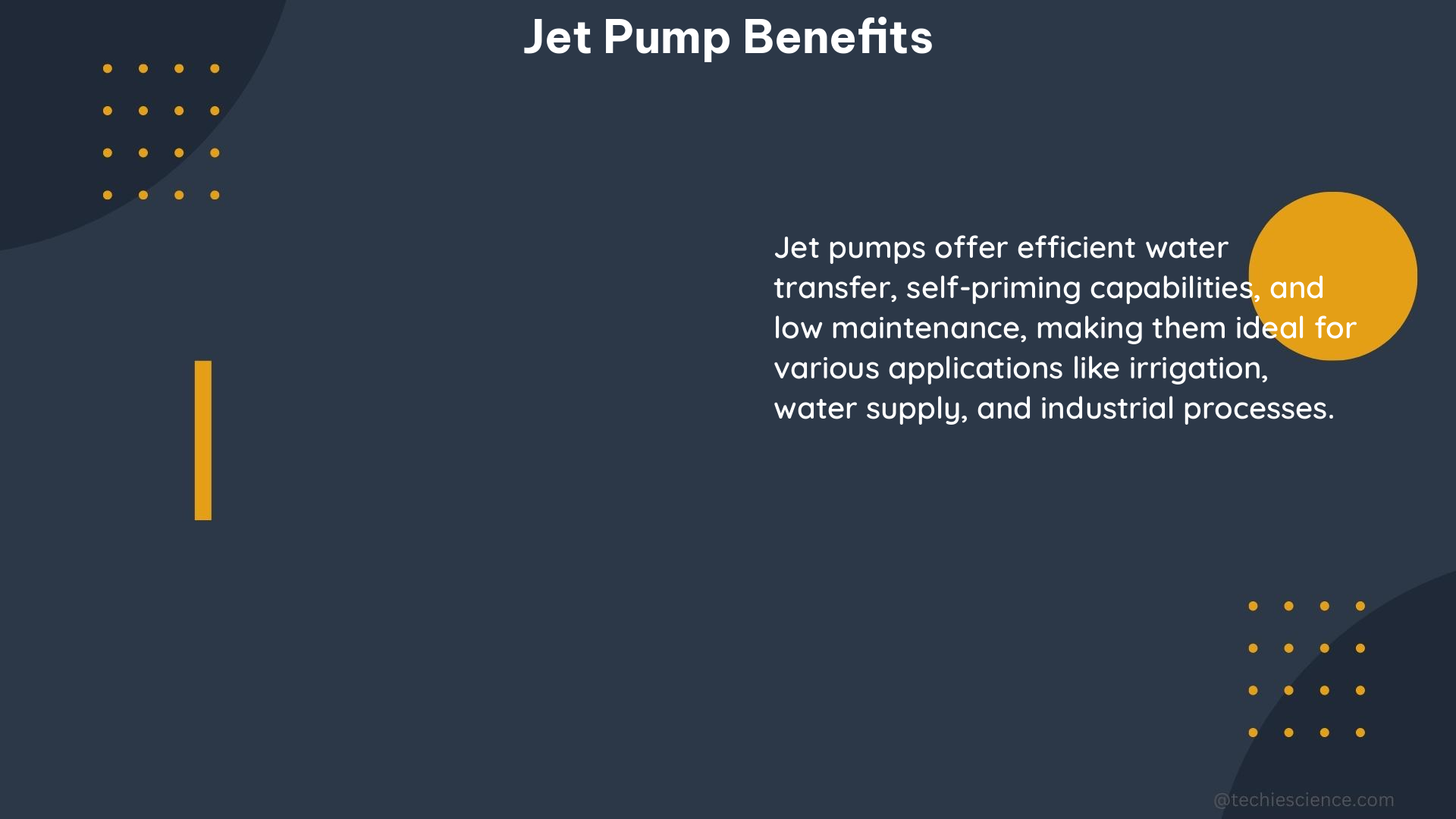Jet pumps offer a remarkable array of benefits, including enhanced efficiency, improved system reliability, and reduced operational costs. This comprehensive guide delves into the technical specifics and quantifiable data points that showcase the true power of these versatile pumping solutions.
Boosting Efficiency: Maximizing Jet Pump Performance
Jet pumps are renowned for their exceptional efficiency, and the latest research has uncovered even more impressive performance metrics.
Optimizing Pressure Ratios for Wider Flow Ranges
A study on the Law of Head Loss of Jet Pumps in Cavitation found that a jet pump without a throat was designed and manufactured to obtain a higher critical pressure ratio (h_cr). This innovative design resulted in a more efficient jet pump that could handle a wider range of flow rates and pressure drops, with the critical pressure ratio (h_cr) reaching as high as 0.85.
Harnessing Swirling Primary Jets for Enhanced Entrainment
Another study on Improving the Efficiency of a Jet Pump using a Swirling Primary Jet revealed that low levels of motive flow swirl could increase fluid entrainment and suction, leading to a remarkable improvement in efficiency. The researchers found that a swirl angle of just 10 degrees could enhance the jet pump’s efficiency by up to 8.5%, with the maximum efficiency reaching an impressive 72.5%.
Annular Jet Pumps: Boosting Liquid Carrying Performance
A study on the liquid carrying performance of annular jet pump gas wells with static mixers uncovered even more impressive efficiency gains. The researchers found that the new annular jet pump (NAJP) design increased the mass flow rate of the sucked fluid by 15.4% year-on-year, while reducing the critical liquid-carrying flow rate by about 10.7%. This resulted in a maximum pumping efficiency of 37%, an increase of about 30.7% year-on-year.
| Design Modification | Efficiency Improvement |
|---|---|
| Jet Pump without Throat | Critical Pressure Ratio (h_cr) up to 0.85 |
| Swirling Primary Jet | Efficiency Increase up to 8.5%, Max Efficiency 72.5% |
| Annular Jet Pump (NAJP) | Mass Flow Rate Increase 15.4%, Critical Liquid-Carrying Flow Rate Reduction 10.7%, Max Efficiency 37% |
These remarkable efficiency gains demonstrate the true potential of jet pumps, making them an increasingly attractive choice for a wide range of applications.
Enhancing System Reliability: Optimizing Jet Pump Performance

Jet pumps are not only efficient, but they also offer enhanced system reliability, thanks to the power of real-time data analysis.
Real-Time Monitoring and Diagnostics
By leveraging real-time data analysis, operators can optimize the performance of their hydraulic jet pump systems. This advanced approach allows for continuous monitoring, diagnosis, and control of the system, enabling the detection and diagnosis of any anomalies or faults. This, in turn, helps prevent or mitigate potential damage or downtime, leading to enhanced system reliability and reduced maintenance costs.
Predictive Maintenance and Fault Prevention
Real-time data analysis can also help predict potential issues before they occur, allowing for proactive maintenance and preventive measures. By monitoring key performance indicators, such as flow rates, pressure, and vibration, operators can identify trends and patterns that indicate the need for maintenance or repairs. This predictive approach helps minimize unplanned downtime, extend the lifespan of the jet pump system, and reduce the frequency of interventions, repairs, and maintenance.
Reducing Operational Costs: Optimizing Resource Consumption
In addition to improved efficiency and enhanced reliability, jet pumps can also contribute to significant cost savings through optimized resource consumption.
Energy Efficiency and Reduced Consumption
Real-time data analysis can help identify opportunities to reduce energy consumption by optimizing the jet pump’s operation. By monitoring and adjusting parameters such as flow rates, pressure, and power usage, operators can fine-tune the system to achieve maximum energy efficiency, leading to substantial cost savings over time.
Water and Chemical Savings
Jet pumps can also help reduce water usage and chemical injection requirements. By optimizing the system’s performance, operators can minimize the amount of water and chemicals needed for the pumping operation, resulting in further cost savings and environmental benefits.
Maintenance and Intervention Reduction
The enhanced reliability and predictive maintenance capabilities of jet pump systems can also lead to a significant reduction in the frequency of interventions, repairs, and maintenance. This, in turn, translates into lower labor costs, fewer equipment replacements, and overall operational cost savings.
Conclusion
Jet pumps offer a remarkable array of benefits, from improved efficiency and enhanced system reliability to reduced operational costs. By leveraging the latest research and technological advancements, operators can unlock the full potential of these versatile pumping solutions, driving improved performance, cost savings, and environmental sustainability.
References:
- Law of Head Loss of Jet Pumps in Cavitation
- Improving the Efficiency of a Jet Pump using a Swirling Primary Jet
- Optimizing Hydraulic Jet Pump System Performance with Real-Time Data Analysis
- Liquid Carrying Performance of Annular Jet Pump Gas Well with Static Mixer

The lambdageeks.com Core SME Team is a group of experienced subject matter experts from diverse scientific and technical fields including Physics, Chemistry, Technology,Electronics & Electrical Engineering, Automotive, Mechanical Engineering. Our team collaborates to create high-quality, well-researched articles on a wide range of science and technology topics for the lambdageeks.com website.
All Our Senior SME are having more than 7 Years of experience in the respective fields . They are either Working Industry Professionals or assocaited With different Universities. Refer Our Authors Page to get to know About our Core SMEs.